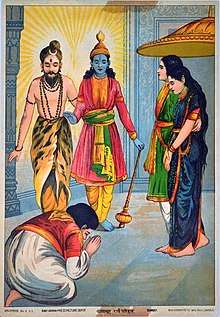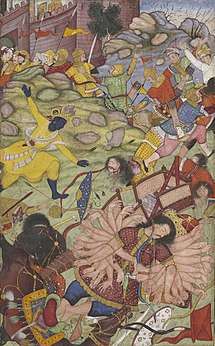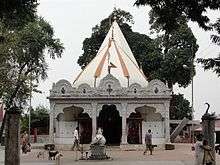Banasura
Bana (also called Banasur) is described as an ancient king of Sonitpura (present-day Tezpur, Assam) in several Hindu Puranic scriptures. Bana was a thousand-armed Asura king, and the son of Mahabali.[1][2]
| Banasura | |
|---|---|
 Banasur battles with Krishna | |
| In-universe information | |
| Family | Bali (father) |
| Children | Usha |
Some other sources say that since Banasur, son of Asur King Mahabali who is believed to be a central character in mythology and culture of Kerala, inherits his kingdom from his father and is believed to have ruled from Kerala. There is a hill named "Banasur Hill" and a dam, "Banasur Sagar Dam" dedicated to the memory of their great ruler's son Bana.
Legend

Banasura, a mighty asura, once ruled over a large kingdom. His influence was so strong and fierce that all the kings - and even some of the devas - shuddered in front of him. Banasura used to worship a Rasalingam given to him by Vishvakarman, on instruction from Vishnu. An ardent devotee of Shiva, he used his thousand arms to play the Mridanga when Shiva was performing the tandava dance. Shiva gave Banasura a boon and the latter requested Shiva to be his protector: therefore, Banasura became invincible. As time passed, he became even more cruel and arrogant. He locked up his daughter, Usha, in a fortress called Agnigarh because many young suitors had come to him asking for her hand. One day, Usha saw a young man in her dream and fell in love with him. Chitraleka was a friend of Usha and daughter of Kumbhanda, Minister of Banasura. Chitralekha was a talented artist who helped Usha to identify the young man seen in her dream by sketching various portraits. She had dreamt of Aniruddha, the grandson of Krishna. Chitralekha, through supernatural powers, abducted Aniruddha from the palace of Krishna and brought him to Sonitpura.[3] Upon meeting Usha, Aniruddha too fell deeply in love with her. When Banasura, came to know about this affair, enraged, he caged Usha in a fortress over a hillock, bounded by fire from all sides. This hillock is situated in the heart of present-day Tezpur. Bana sent guards to seize Aniruddha, but he fought valiantly and defeated them. Bana then by using the powers granted to him by Shiva, bound him with snakes and imprisoned him too. In the meantime, Narada narrated the entire series of events to Krishna. Furious Krishna, alongwith Balaram, Pradyumna, Satyaki, lead the twelve Akshauhinis of the army. They seized Sonitpura from all sides. [4][5][6][7] Bana also attacked Krishna’s army with equal might, but he began to feel powerless in front of Lord Krishna. Thus, he evoked Lord Shiva to take his side. Shiva, confined to his abode along with his son Kartikeya, came to his aide. A tumultuous battle ensued between the two Lords, which became a spectacle among all other Gods, heavenly beings and sages. Even the Bhutas, Pretas, Pishachas, Dakinis and Rakshas, couldn’t win over Krishna. Many weapons were fired at Krishna by Lord Shiva, but he countered them all. Shiva’s own Pasupatastra was countered by Krishna’s own Narayanastra. The war became more intense, when Shiva spewed fire in all directions releasing his three headed and three legged form (also known as Mahesvari Jvara). To counter this, Krishna released Vishnu-jawara. Krishna now put Shiva to sleep using Jrumbhanastra. After Shiva, falls into a slumber, Krishna recalls his discus, and uses it to cut Bana's thousand arms systematically, like the branches of a huge tree. Seeing Krishna releasing his Sudarshan Chakra to sever his head, Banasura once again invokes Lord Shiva. True to the plight of his devotee, Shiva aroused from his slumber, approached Krishna and asked him to spare Bana’s life. After that Krishna forgave Bana.[8][9]
After the war, Aniruddha married Banasura's daughter Usha[10] who later gave birth to Vajra, grandson of Pradyumna and the great-grandson of Krishna and Rukmini.
Family

The genealogy of Banasura is as follows:[11]
- Brahma's son was Marichi
- Marichi's son was Kashyapa,
- Kashyapa's sons were Hiranyakashipu and Hiranyaksha,
- Hiranyakashipu's son was Prahlada,
- Prahlada's son was Virochana,
- Virochana's son was Bali,
- Bali's son was Banasura
Banasura's story has been narrated in Indian epic Mahabharata and Bhagavata Purana. His story as the rejected suitor for goddess Shakti is present in Tamil Sangam literary works Manimekalai and Puranaanooru; Bhattavataar's Banasura Katha.[12]
Legacy

.jpg)
- According to Hindu mythology, Agnigarh hillock was built by Banasura to keep his daughter Usha in isolation.[13]
- Mahabhairav Temple is believed to have been established by king Bana with a Siva lingam. Formerly, this temple was built of stone but the present one is built of concrete. During the later years, the Ahom kings donated devottar land for the Temple and Pujaris and Paiks were appointed to look after the temple.[14]
- To the east of Tezpur town, on the bank of river Brahmaputra a temple call Rudrapada is situated. It is believed that Rudra ( Lord Shiva ) had left the print of his left foot (pada) on a stone found in the temple. It is believed that Mahadeva showed his real self to king Bana here.[15]
- Banasura Sagar Dam is named after Banasura because he was the son of Mahabali and as per local belief Mahabali was a very respected king of Kerala.
References
- krishna.com - Glossary description
- Kumar, Anu (30 November 2012). Banasura: The Thousand-Armed Asura. Hachette India. ISBN 978-93-5009-537-9.
- M. Padmanabhan; Meera Ravi Shankar (1 August 2004). Tales of Krishna from Mahabharatha. Sura Books. pp. 56–57. ISBN 978-81-7478-417-9.
- Vanamali (2012). The Complete Life of Krishna. Simon and Schuster. ISBN 978-1594776908.
- Stephen Knapp (January 0101). Krishna Deities and Their Miracles. Prabhat Prakashan.
- Krishna. Har Anand Publications. 2009. p. 68. ISBN 978-8124114223.
- Chandra sekhar Singh. The Purans volume-02. Lulu.com. ISBN 1365593274.
- https://books.google.co.in/books?id=7UxuAAAAMAAJ&q=Banasura+krishna+shiva+sleep&dq=Banasura+krishna+shiva+sleep&hl=en&sa=X&ved=0ahUKEwiq67_PyvTpAhUUQH0KHfjFDE4Q6AEIWTAH
- https://www.harekrsna.com/philosophy/associates/demons/dwarka/banasura.htm
- Swami, Bodhasarananda (2 March 2016). Stories from the Bhagavatam. Advaita Ashrama. ISBN 978-81-7505-814-9.
- Bhaleram Beniwal: Jāt Yodhāon ke Balidān, Jaypal Agencies, Agra 2005
- Kalla, Krishan Lal. The Literary Heritage of Kashmir. Jammu and Kashmir (India): Mittal Publications. p. 11.
- "Agnigarh | Sonitpur District | Government Of Assam, India". sonitpur.gov.in. Retrieved 13 June 2020.
- "Mahabhairab Temple | Sonitpur District | Government Of Assam, India". sonitpur.gov.in. Retrieved 13 June 2020.
- "Rudrapada Temple | Sonitpur District | Government Of Assam, India". sonitpur.gov.in. Retrieved 13 June 2020.
Sources
- Dictionary of Hindu Lore and Legend (ISBN 0-500-51088-1) by Anna Dhallapiccola
- Acharya Chandra Shekhar Shastri: Puranon ki Anmol Kahanian, 2006 ISBN 81-902258-6-3
